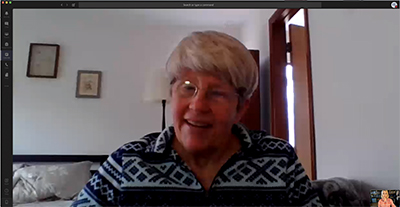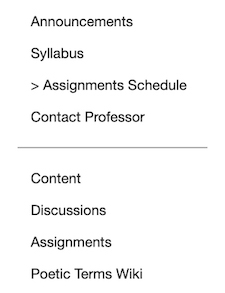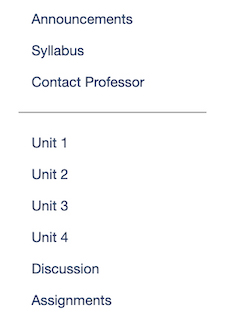| |
 |
| |
Adjunct biology professor Debbie Keith-Serafy is among the faculty who collaborated with me during the shift to remote learning. (photo by Cynthia Eaton) |
| |
|
“Cynthia, I can’t run my toaster oven. How am I going to run an online class? I don’t want to be an online professor. You have to help me.”
(Please note: As I wrote in a recent article for NEA Today, we need to remember there is a considerable difference between online education and the remote learning we are doing now.)
Just-in-time training
A colleague made the above plea on Monday, March 9, in the Eastern Campus Teaching and Learning Center as we worked through the basics of Blackboard together. Having received a warning that the college would likely shift to remote instruction due to the coronavirus pandemic, four of us Eastern Campus faculty started training colleagues whenever we weren’t in class or meetings that week.
During the week of March 16, our spring recess, I donned protective gear and volunteered to be in a computer lab on campus every day from 9 a.m. to 3 p.m., continuing those Blackboard trainings. With colleagues coming in and out every day, I made sure everyone was spaced no less than six feet apart and wiped all surfaces religiously.
I’ve continued helping colleagues from afar since then—fielding emails, answering phone calls, video chatting via MS Teams and Zoom—and I am resoundingly impressed by our colleagues’ perseverance in making this sudden pivot to remote learning and their determination to do what’s best for their students every step of the way.
Really impressed.
I taught my fully online first course in spring 1998 and have used four different course management systems, so I’m comfortable in online spaces. But these colleagues are all on-campus faculty and only a few had been using Blackboard a little to web-enhance their classes.
Imagine being adept at working with students in person, in a physical space, and suddenly having no choice but to do your work from a distance, using a tool you’ve never used before?
Yet they did it.
Rolling up their sleeves
I watched them put in hours of hard work in the lab, go home and build, come back the next day to learn more, then spend hours building more. Their questions showed such care for how each of their decisions might impact their students. We engaged in some genuinely thought-provoking pedagogical conversations. Consider some of these examples, and you’ll have a sense of what I mean:
- A previously low-tech anatomy and physiology adjunct figured out that the best way to get some lectures to students is by creating a private YouTube channel, recording their videos and uploading them to Blackboard—all while actually learning Blackboard.
- A faculty member teaching English language learners who mostly speak very little English was working through how to reach their students about how to even access Blackboard. There’s a general prohibition against speaking English in these courses but in this situation, was it okay to convert my student Blackboard Basics help files to Spanish?
- An economics professor spent days working through the various ways to present lecture material, then purchased his own microphone, speakers and white board to record some and used audio narration in PowerPoint slides for others.
- Student services colleagues on all three campuses were deeply engaged in not only learning Blackboard so they could better respond to student questions but also in setting up Blackboard Community spaces for advisement and counseling to continue from a distance. I hosted a two-hour web conference for student services on March 26 and I saw that many were very concerned about ensuring student privacy as well as maintaining accessibility in all interactions.
- A history professor wanted to learn all the ways students could submit essays. I reviewed all of the options: discussion board, email, assignments area, test or even in the blogs, wiki or journal tools. Once we talked through the benefits and drawbacks of each (e.g., some are private to the professor, others are public to everyone in the class), he made a decision and set off to build that space in the class website.
- Several faculty in the sciences (biology, chemistry, meteorology, astronomy) spent hours working out the best way to conduct quizzes and tests online in a way that maintains academic integrity but also allows a reasonable measure of flexibility given the conditions.
Our conversations included setting time limits, different types of test questions (e.g., how multiple answer is more challenging than multiple choice, how to use the hot spot question to assess student comprehension, etc.), how to make true/false questions worth fewer points than short answer and how to embed new information in quiz feedback that will land on the next exam to better ensure students actually read your quiz feedback rather than merely glance at their grade and walk away.
- A faculty member in dietetic technology was worried about how to reach students who aren’t logging in, a biology adjunct worked with me and with the Open SUNY help desk for days on end to figure out why a few students weren’t able to see his written comments and an art faculty member worked for days to figure out how to conduct their course from afar.
- A foreign language professor spent days determining the pros and cons of the various ways to assess the spoken aspects of the course, then spent yet more time setting up their preferred solution.
- Another faculty member wanted to use Collaborate and/or Teams to do video conferencing with students but was very concerned about students who wouldn’t even log in due to shyness or wanting to keep their home life private. I assured her that students could come into both web conferencing spaces with their audio on but video off so they could listen and speak but not be seen if that’s what they preferred. I appreciated this professor’s sensitivity to their students.
- A math professor wanted to know how to view their course materials from the student perspective. I taught them how to enter student preview, and they built and then completed in student preview every single test to make sure they understood exactly what each one would feel like to students.
- A professor came in with questions about using Collaborate versus Teams, specifically could Collaborate be used to give a lecture to all three sections of a single course at once? We discussed how Collaborate was embedded within each individual section’s class website, so that wouldn’t work. But even using Teams for that purpose would be fraught with issues since it wouldn’t be fair to change the days and times of the lectures, given students’ various—and changing because of coronavirus—work schedules and family and other obligations. This professor decided to use Teams for weekly office hours open to all three sections and to develop other means for delivering course content.
 |
|
| |
|
| |
 |
| |
|
I also learned a great deal. Over the years, I’ve developed my own structure in my Blackboard courses, but I enjoy seeing how faculty in other areas would, for example, not leave Content as a main section in their course menu but delete that and add each of their units as the main sections in their course menu.
Every cloud has a silver lining
Let me be clear: There is little good to say about this pandemic. In the U.S. over half a million people have become ill, nearly 17 million have filed for unemployment, over 20,000 people have died and the situation has shed light on a number of negative aspects about our country.
But I do see some flickers of light in this darkness.
As a union officer, it makes me very happy to see firsthand how diligent our members are in teaching and advising and counseling our students. They are feeling uncertain and scared themselves, yet these faculty are so mindful of the need to balance academic standards with understanding our students as people who are in an even more difficult situation than we find ourselves in.
As a person, it makes me very happy to have made some new acquaintances from this process. I don’t often get to interact with faculty in areas like math or science or criminal justice and, even after nine years as adjunct coordinator for the FA, I got to meet some really terrific part-time faculty. Their work ethic and gentle, self-deprecating humor inspires me.
I am more proud than ever to be an officer of our union and to represent such strong, smart members. On behalf of the FA, I thank each and every one for their good work. |


